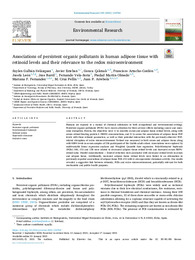Por favor, use este identificador para citar o enlazar este ítem:
https://hdl.handle.net/11000/37574Registro completo de metadatos
| Campo DC | Valor | Lengua/Idioma |
|---|---|---|
| dc.contributor.author | Galban-Velázquez, Suylen | - |
| dc.contributor.author | Esteban Mozo, Javier | - |
| dc.contributor.author | Çakmak, Gonca | - |
| dc.contributor.author | Artacho-Cordón, Francisco | - |
| dc.contributor.author | León, Josefa | - |
| dc.contributor.author | Barril, Jose | - |
| dc.contributor.author | Vela-Soria, Fernando | - |
| dc.contributor.author | MARTIN-OLMEDO, PIEDAD | - |
| dc.contributor.author | Fernández, Mariana Fátima | - |
| dc.contributor.author | Pellín, M. Cruz | - |
| dc.contributor.author | Arrebola, Juan P. | - |
| dc.contributor.other | Departamentos de la UMH::Biología Aplicada | es_ES |
| dc.date.accessioned | 2025-09-30T09:27:25Z | - |
| dc.date.available | 2025-09-30T09:27:25Z | - |
| dc.date.created | 2021-01-23 | - |
| dc.identifier.citation | Environmental Research, Volume 195, April 2021, 110764 | es_ES |
| dc.identifier.issn | 0013-9351 | - |
| dc.identifier.uri | https://hdl.handle.net/11000/37574 | - |
| dc.description.abstract | Humans are exposed to a myriad of chemical substances in both occupational and environmental settings. Persistent organic pollutants (POPs) have drawn attention for their adverse effects including cancer and endocrine disruption. Herein, the objectives were 1) to describe serum and adipose tissue retinol levels, along with serum retinol binding protein 4 (RBP4) concentrations, and 2) to assess the associations of adipose tissue POP levels with these retinoid parameters, as well as their potential interaction with the previously-observed POPrelated disruption of redox microenvironment. Retinol was measured in both serum and adipose tissue along with RBP4 levels in serum samples of 236 participants of the GraMo adult cohort. Associations were explored by multivariable linear regression analyses and Weighted Quantile Sum regression. Polychlorinated biphenyls (PCBs) 180, 153 and 138 were related to decreased adipose tissue retinol levels and increased serum RBP4/ retinol ratio. Dicofol concentrations > limit of detection were associated with decreased retinol levels in serum and adipose tissue. Additionally, increased adipose tissue retinol levels were linked to an attenuation in previously-reported associations of adipose tissue PCB-153 with in situ superoxide dismutase activity. Our results revealed a suggestive link between retinoids, PCBs and redox microenvironment, potentially relevant for both mechanistic and public health purposes. | es_ES |
| dc.format | application/pdf | es_ES |
| dc.format.extent | 11 | es_ES |
| dc.language.iso | eng | es_ES |
| dc.publisher | Elsevier | es_ES |
| dc.rights | info:eu-repo/semantics/openAccess | es_ES |
| dc.rights | Attribution-NonCommercial-NoDerivatives 4.0 Internacional | * |
| dc.rights.uri | http://creativecommons.org/licenses/by-nc-nd/4.0/ | * |
| dc.subject | Persistent organic pollutants | es_ES |
| dc.subject | Polychlorinated biphenyls | es_ES |
| dc.subject | Retinoid system | es_ES |
| dc.subject | Superoxide dismutase | es_ES |
| dc.subject | Oxidative stress | es_ES |
| dc.subject.other | CDU::5 - Ciencias puras y naturales::57 - Biología | es_ES |
| dc.title | Associations of persistent organic pollutants in human adipose tissue with retinoid levels and their relevance to the redox microenvironment | es_ES |
| dc.type | info:eu-repo/semantics/article | es_ES |
| dc.relation.publisherversion | https://doi.org/10.1016/j.envres.2021.110764 | es_ES |

Ver/Abrir:
Galban.pdf
2,76 MB
Adobe PDF
Compartir:
 La licencia se describe como: Atribución-NonComercial-NoDerivada 4.0 Internacional.
La licencia se describe como: Atribución-NonComercial-NoDerivada 4.0 Internacional.
.png)